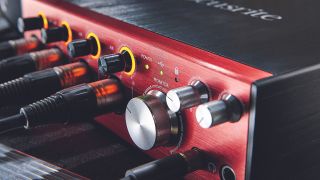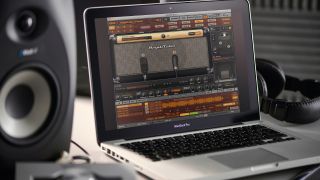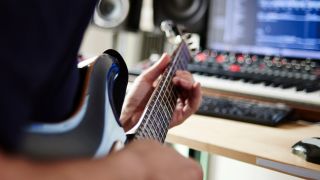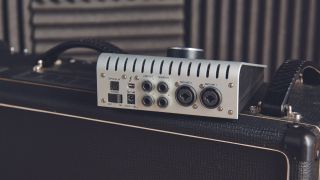If you’ve ever recorded guitars before, you’ve probably always subscribed to the mantra of turning it up enough to get a good signal, but not so high that you’re clipping. Seems pretty logical, and in fact this is the way you’d record something using a microphone in a studio. But what if you’re using a guitar plugin with an audio interface? Surely the same rules apply?
Turns out it’s not quite that simple. Before the mini furor of YouTube videos explaining how we’d all been recording our guitars wrong emerged earlier this year, there was a lot of misleading advice out there on how you should record guitars using an audio interface, including directly from manufacturers like Line 6 and Neural DSP.
Normal gain staging

As you would in a studio, many online advised plugging into the instrument input of your interface (or pressing the appropriate instrument button) and turning your gain up until your signal peaks between -14dB and -9dB for the best sound.
Recording this way minimizes noise, while also ensuring that each part of your signal chain is receiving the optimal signal. It’s the Goldilocks zone of signal, not too hard and not too soft, and a general rule of thumb for recording anything.
Only it turns out this isn’t actually the way to get a great guitar tone when using plugins.
The new normal

For the past year or so since I finally relented and bought myself a HX Stomp and Helix Native, it’s how I’ve been doing it. Whilst I don’t think all my tones have been bad - at least to my ears - sometimes I would struggle to get a truly nice clean tone on particular presets. I’d also find myself consistently turning the simulated amp gain down on the heavier presets, wondering how the maker could have ever found such an oversaturated tone usable.
It was only once I discovered a video by popular YouTuber John Nathan Cordy that I realised I’d been going about using guitar plugins completely wrong. Turns out all that savvy online recording advice about gain staging wasn’t actually applicable in this scenario, despite it appearing obvious to anyone who knows anything about recording. This video then led me down the rabbit hole to YouTube user Ed S, who’d been putting in a lot of work educating guitarists on how to properly use their plugins.
How to get a better tone

If you’ve been struggling with getting a good sound from your guitar plugged directly into your interface, then start by turning the gain on your interface all the way down to the minimum value. Then, you’ll need to adjust your plugin input gain to the default level, usually zero, which should get your simulated amplifier to act more like the real thing.
If you’re using a Universal Audio or Focusrite audio interface alongside a Neural DSP or Line 6 Helix plugin, then setting your interface gain level to zero with the same setting in your plugin should get you the right input level. For other combinations, you can see Ed’s super useful table linked in the video above, which shows a range of audio interfaces, plugins, and what gain settings you should be using.
Further adjustments

As Ed's video explains, setting everything to zero will cover a lot of cases but there is a little more nuance to it than that. Each audio interface will have a different maximum input level for the instrument input, which means you may need to add a little gain, or even use a trim plugin in your DAW to lower the input level for your particular interface and plugin combination.
Ed contacted me about this article after it was published, and made some really good points about getting your input gain right.
"Basically the whole concept of calibrating is so you can treat amp sims like you would a real amp. With a real amp, you plug the guitar straight in and use the gain knob on the amp itself."
Also if you're worried about the effect of different guitar pickups like I was, don't be. Ed had this to say on the subject.
"So the whole point of it is to use a single input for level for any pickups, be it single coil, humbucker, P90, bass, etc. That way you are preserving the original level and relative differences between each instrument, just as you would happen with a real amp."
Of course, we’d always encourage you to listen with your ears and not your eyes, so you may want to further tweak your own settings to your personal taste, but it’s a great starting point to get better guitar tones in the box, and get your simulated amplifier sounding more like the real thing.
"interface" - Google News
June 27, 2024 at 07:16PM
https://ift.tt/dyfBxYM
How to use an amp simulator with an audio interface - MusicRadar
"interface" - Google News
https://ift.tt/iFtx0aA
https://ift.tt/C4fPHwn
Bagikan Berita Ini














0 Response to "How to use an amp simulator with an audio interface - MusicRadar"
Post a Comment